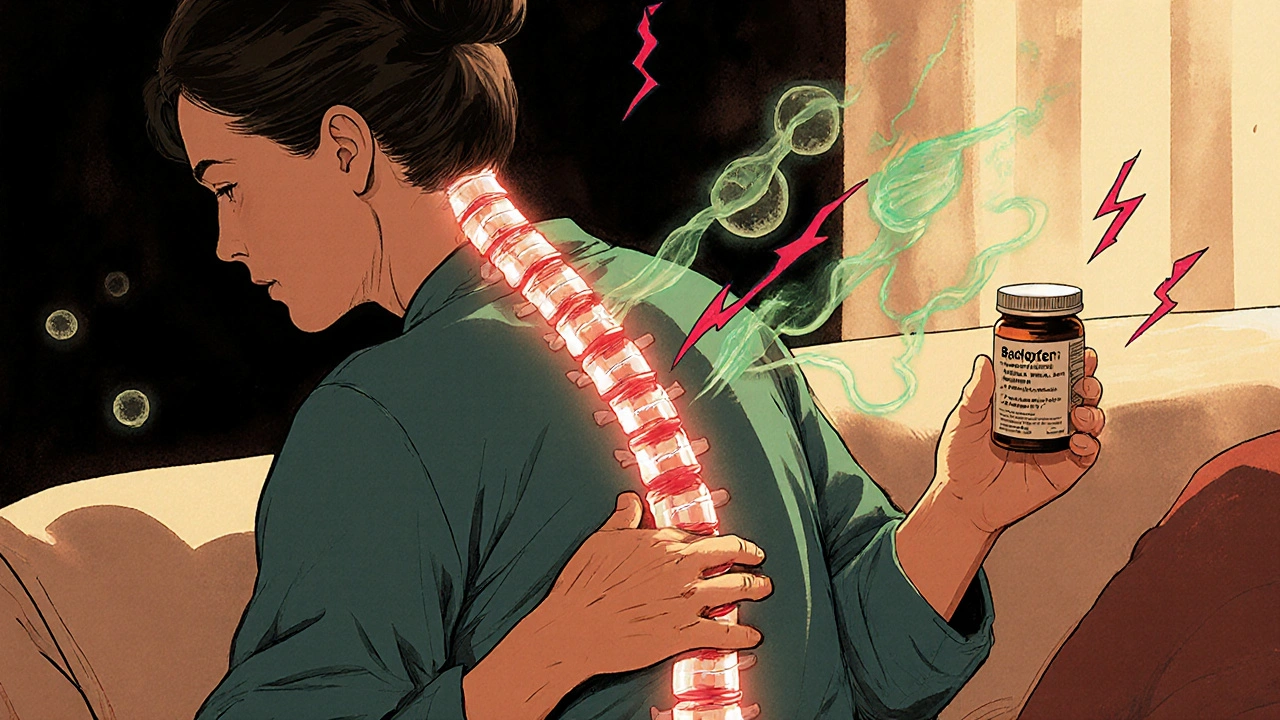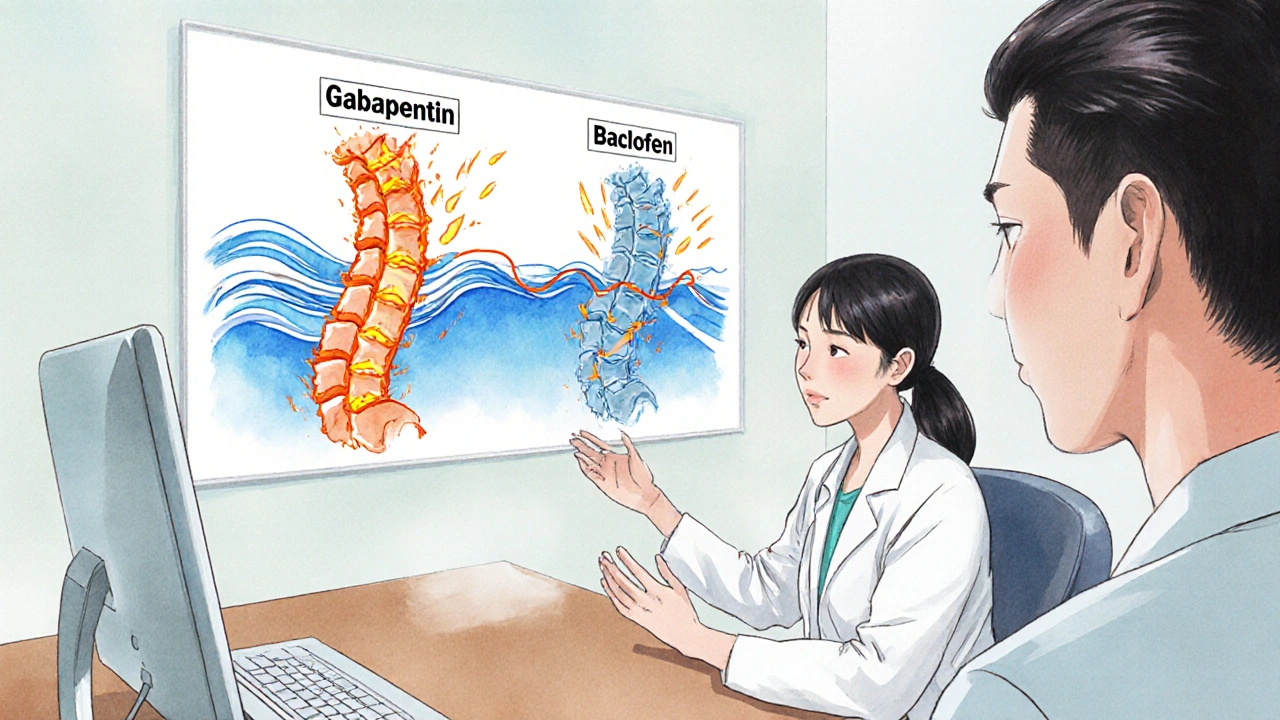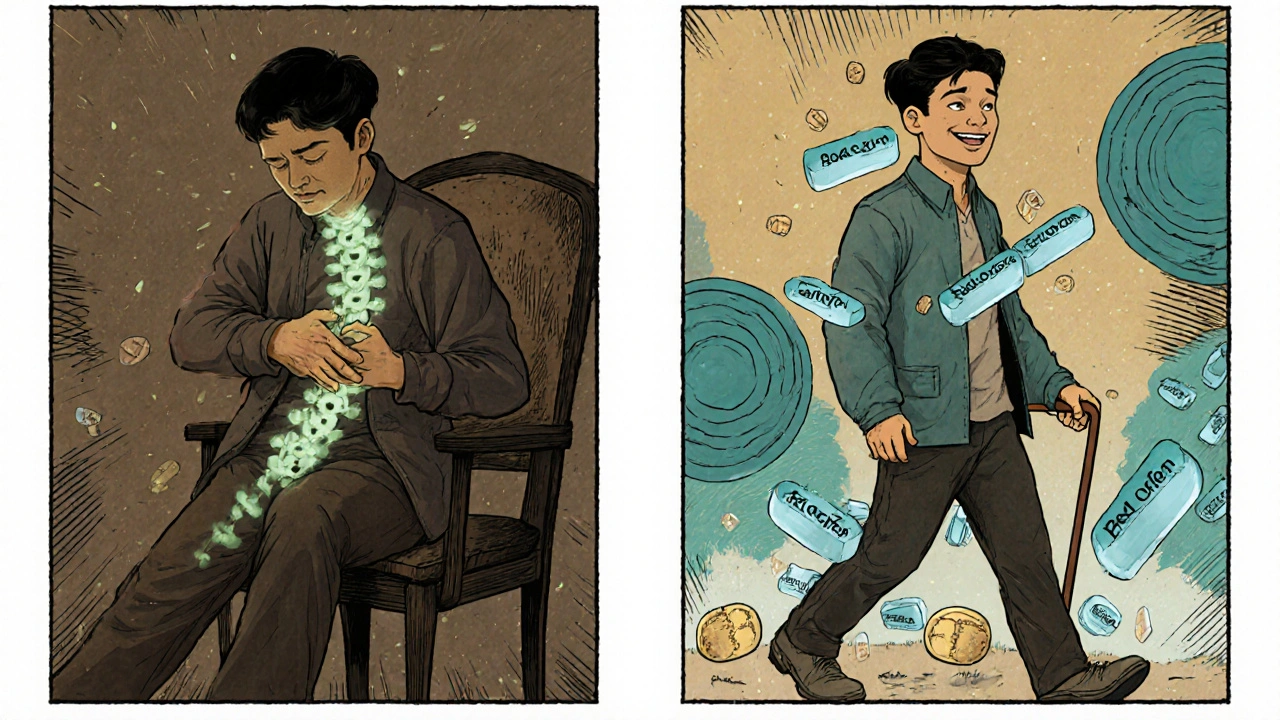Baclofen for Tarlov Cysts: Does It Really Help with Pain?
 Oct, 31 2025
Oct, 31 2025
When you’re dealing with chronic pain from Tarlov cysts, finding relief can feel like searching for a needle in a haystack. These fluid-filled sacs form around nerve roots at the base of your spine, and when they press on nerves, they cause sharp, burning, or shooting pain that radiates into your buttocks, legs, or even genitals. Many people try physical therapy, injections, or even surgery-but not everyone finds lasting relief. That’s where baclofen comes up in conversations. Is it just another option on the list, or could it actually help manage the pain from Tarlov cysts?
What Are Tarlov Cysts?
Tarlov cysts, also known as perineural cysts, are benign sacs filled with cerebrospinal fluid that develop along the nerve roots in the sacrum-the triangular bone at the bottom of your spine. They’re not tumors, and they’re not always symptomatic. In fact, many people have them and never know. But when they grow large enough, they can compress nearby nerves, leading to pain, numbness, tingling, or even bladder and bowel dysfunction.
Unlike herniated discs or spinal stenosis, Tarlov cysts don’t show up clearly on standard MRI scans unless the radiologist is specifically looking for them. That’s why diagnosis often takes years. Patients are frequently misdiagnosed with sciatica, piriformis syndrome, or even fibromyalgia before someone finally spots the cysts on a high-resolution MRI of the sacrum.
How Does Baclofen Work?
Baclofen is a muscle relaxant originally developed in the 1960s to treat spasticity from conditions like multiple sclerosis and spinal cord injuries. It works by mimicking the action of GABA, a neurotransmitter that naturally calms nerve activity in the spinal cord. By binding to GABA-B receptors, baclofen reduces the overactive signals that cause muscles to tighten uncontrollably.
But its effect isn’t just limited to muscles. Because GABA-B receptors are also found in pain pathways, baclofen can dampen the way nerves send pain signals to the brain. This is why it’s sometimes prescribed off-label for neuropathic pain-pain caused by damaged or irritated nerves. And that’s exactly what happens in Tarlov cysts: the cyst presses on nerves, making them fire abnormally, creating chronic pain.
Why Would Baclofen Be Considered for Tarlov Cysts?
There’s no FDA-approved drug specifically for Tarlov cyst pain. Surgery is the only cure, but it’s risky and not always successful. Many patients turn to medications to manage symptoms, including gabapentin, pregabalin, tricyclic antidepressants, or NSAIDs. But these don’t always work well for everyone.
Baclofen offers a different approach. Instead of targeting inflammation or general nerve firing like gabapentin, it directly calms the spinal cord’s pain signaling system. For patients whose pain feels like electric shocks, muscle spasms, or deep aching that worsens with movement, baclofen’s mechanism can be a better fit.
A 2021 case series published in Neurology and Clinical Neuroscience followed five patients with symptomatic Tarlov cysts who hadn’t responded to other treatments. Three of them reported at least a 40% reduction in pain after adding baclofen to their regimen. One patient, a 52-year-old woman with severe sciatica-like pain that kept her from sleeping, said she could finally lie on her side again after two weeks on 10 mg of baclofen three times a day.
What Does the Evidence Say?
Let’s be clear: there are no large clinical trials proving baclofen works for Tarlov cysts. Most of the support comes from case reports, small studies, and clinical experience. That doesn’t mean it’s useless-it just means the evidence isn’t strong enough to make it a standard recommendation.
But here’s what doctors see in practice: baclofen helps when the pain has a spastic or nerve-hyperexcitability component. If your pain flares up with movement, worsens when you sit for long periods, or feels like your leg is “tightening up,” baclofen might help. If your pain is more of a constant dull ache or burning sensation without muscle tension, gabapentin or amitriptyline might be better.
One key thing to note: baclofen doesn’t shrink the cyst. It doesn’t fix the root cause. It only helps manage how your nerves react to the pressure. That’s an important distinction. Think of it like turning down the volume on a speaker that’s too loud-not removing the speaker itself.

How Is Baclofen Dosed for This Use?
If your doctor considers baclofen for your Tarlov cyst pain, they’ll start low and go slow. Typical starting doses are 5 mg once or twice a day. The dose is gradually increased every few days, depending on tolerance and response. Most people who benefit take between 15 mg and 30 mg per day, split into three doses.
It’s not uncommon to feel drowsy, dizzy, or weak at first. These side effects usually fade after a week or two as your body adjusts. But if you feel too groggy, your doctor might switch you to a slow-release version, which provides steadier levels and fewer peaks and crashes.
Never stop baclofen suddenly. Abruptly discontinuing it can cause withdrawal symptoms like hallucinations, seizures, or rebound muscle spasms. Always taper down under medical supervision.
Who Should Avoid Baclofen?
Baclofen isn’t safe for everyone. You should avoid it if you:
- Have a history of peptic ulcers or kidney disease (it’s cleared by the kidneys)
- Are pregnant or breastfeeding (limited safety data)
- Have epilepsy or a seizure disorder (can lower seizure threshold)
- Are taking other CNS depressants like opioids, benzodiazepines, or alcohol
Also, if you’ve tried baclofen before for spasticity and it didn’t help-or made your pain worse-it’s unlikely to work for Tarlov cysts either.
Real-Life Experience: What Patients Say
One patient from Perth, 48, who’d been living with Tarlov cyst pain for seven years, started baclofen after three failed epidural injections. She told her neurologist, “It didn’t make the pain disappear, but it took the edge off. I could walk to the mailbox without my leg locking up.” She’s now on 20 mg daily and says it’s the first thing that’s let her sleep through the night in years.
Another man, 61, tried baclofen for six weeks but stopped after getting too dizzy. “It felt like my brain was underwater,” he said. “I couldn’t drive.” That’s not unusual. Not everyone tolerates it. But for those who do, the difference can be life-changing.

Other Options to Consider
If baclofen doesn’t work or causes too many side effects, there are other medications and approaches:
- Gabapentin or pregabalin: These target nerve firing and are often first-line for neuropathic pain.
- Amitriptyline or duloxetine: Antidepressants that help with chronic nerve pain and sleep disruption.
- Spinal cord stimulation: A small device implanted under the skin sends mild electrical pulses to block pain signals.
- Cyst aspiration or surgical decompression: In severe cases, doctors may drain the cyst or remove part of the bone to relieve pressure.
Some patients combine baclofen with physical therapy focused on gentle core stabilization and posture correction. Avoiding prolonged sitting and using a coccyx cushion can also reduce pressure on the sacrum.
When to Talk to Your Doctor About Baclofen
If you’ve been diagnosed with Tarlov cysts and your pain isn’t controlled by over-the-counter meds or standard nerve pain drugs, ask your neurologist or pain specialist about baclofen. Bring up:
- Whether your pain feels like muscle tightness or nerve shocks
- If movement makes it worse
- Whether you’ve tried other nerve pain medications without success
Your doctor may order a repeat MRI to confirm the cyst size and location, and check your kidney function before prescribing. They might also suggest a trial period of 4-6 weeks to see if it helps.
Bottom Line: It’s Not a Cure, But It Might Help
Baclofen won’t make your Tarlov cysts disappear. It won’t reverse nerve damage. But for some people, it reduces the intensity of the pain signals that make daily life unbearable. It’s not a miracle drug, but it’s one of the few options that targets the nerve hyperactivity tied to cyst pressure.
If you’re tired of painkillers that don’t work and surgeries that feel too risky, baclofen might be worth a trial. Start low. Be patient. Track your symptoms. And don’t give up if the first dose feels too strong-adjustments can make all the difference.
Can baclofen shrink Tarlov cysts?
No, baclofen does not shrink Tarlov cysts. It only helps manage the nerve pain caused by the cyst pressing on surrounding nerves. It works by calming overactive pain signals in the spinal cord, not by reducing the size of the cyst itself.
How long does it take for baclofen to work for Tarlov cyst pain?
Most people start noticing a difference in nerve pain within 1 to 2 weeks of starting baclofen, especially after the dose is gradually increased. Full effects may take up to 4 to 6 weeks. It’s not an instant fix, but consistent dosing matters.
Is baclofen better than gabapentin for Tarlov cyst pain?
It depends on the type of pain. Gabapentin works well for burning, tingling, or electric shock pain. Baclofen is more effective when the pain is tied to muscle tightness, spasms, or pain that worsens with movement. Some patients benefit from using both together under medical supervision.
Can you take baclofen long-term for Tarlov cysts?
Yes, many people take baclofen long-term for chronic nerve pain, as long as they tolerate it well and kidney function stays normal. Regular check-ups with your doctor are important to monitor for side effects and adjust the dose if needed.
What are the most common side effects of baclofen?
The most common side effects include drowsiness, dizziness, weakness, fatigue, and nausea. These usually improve after the first week or two. Less common but serious side effects include confusion, hallucinations, or seizures-especially if the dose is increased too quickly or stopped suddenly.

Suresh Patil
November 1, 2025 AT 02:00Baclofen didn't work for me with my Tarlov cysts, but I tried it after reading this and figured I'd share. I was on 20mg/day for six weeks. Felt like walking through syrup most days. Couldn't focus at work. But the electric zaps in my leg? Yeah, those got quieter. Not gone, just less violent. I stopped because the drowsiness was worse than the pain. Still, I'm glad someone wrote this - it's rare to find real talk about this stuff.
Ram Babu S
November 2, 2025 AT 01:23My uncle in Delhi had this. Doctors there said it was sciatica for three years. Then he got an MRI after falling - cysts everywhere. Tried gabapentin, then baclofen. Said the baclofen let him sit on the floor to pray again. No magic, just less screaming nerves. He’s on 15mg now. Still walks slow, but he walks. India’s got no pain specialists, so we’re all just guessing. This post helps.
Kyle Buck
November 3, 2025 AT 04:17While the clinical evidence remains anecdotal and confined to case series, the pharmacodynamic profile of baclofen - specifically its agonism at GABA-B receptors within the dorsal horn of the spinal cord - provides a biologically plausible mechanism for attenuation of neuropathic nociception in perineural cyst pathology. The absence of large-scale RCTs precludes its inclusion in formal guidelines, yet its off-label utility in refractory cases warrants consideration within a multidisciplinary pain management paradigm, particularly when spasticity or dynamic nerve compression is clinically evident. Further investigation into biomarkers of GABAergic responsiveness may stratify potential responders.
Amy Craine
November 4, 2025 AT 07:06I’m a chronic pain nurse and have seen this play out over and over. Baclofen isn’t a cure, but for patients who’ve tried everything else - gabapentin, SNRIs, even nerve blocks - it’s often the last thing before surgery. The key is pacing the titration. Start at 5mg at night. If they tolerate it, bump to 5mg twice a day after three days. Never rush it. And always, always warn them about withdrawal. I’ve had patients come in shaking, hallucinating because they quit cold turkey. This post nails the nuance. Thank you.
Alicia Buchter
November 5, 2025 AT 19:15Oh please. Another ‘maybe baclofen works’ post. Like we haven’t seen this 500 times on Reddit. Everyone’s like ‘oh it helped my electric leg pain’ - but did you try physical therapy? Did you get a sacral nerve stimulator? Or are you just lazy and want a pill? Also, ‘40% reduction’? That’s not relief, that’s ‘I can now tolerate my own existence.’
MaKayla VanMeter
November 6, 2025 AT 18:46OMG I’M SO DONE WITH THIS. I tried baclofen. It made me feel like a zombie who forgot how to talk. 😵💫 I cried in the grocery store because I couldn’t lift my arm to grab cereal. 🥲 I’d rather have the pain. At least the pain is REAL. This drug is just… soul murder. 🙃
Doug Pikul
November 6, 2025 AT 22:37MaKayla, you’re not wrong - it sucked for you. But not everyone’s the same. My cousin had the same cysts, tried everything, then baclofen. Now he bikes 10 miles a day. It’s not magic, but it’s not a trap either. Don’t hate on something just because it didn’t work for you. This is real life, not a TikTok trend. 💪
anthony perry
November 7, 2025 AT 23:59Baclofen helps some. Not all. Dose slow. Don’t quit cold. That’s it.
Sarah Major
November 9, 2025 AT 17:24How is it even legal to prescribe this? People are just taking random drugs off-label because doctors are too lazy to refer them to proper specialists. You’re all just gambling with your nervous systems. And now you’re sharing anecdotes like they’re science? This is why America’s healthcare is a joke.